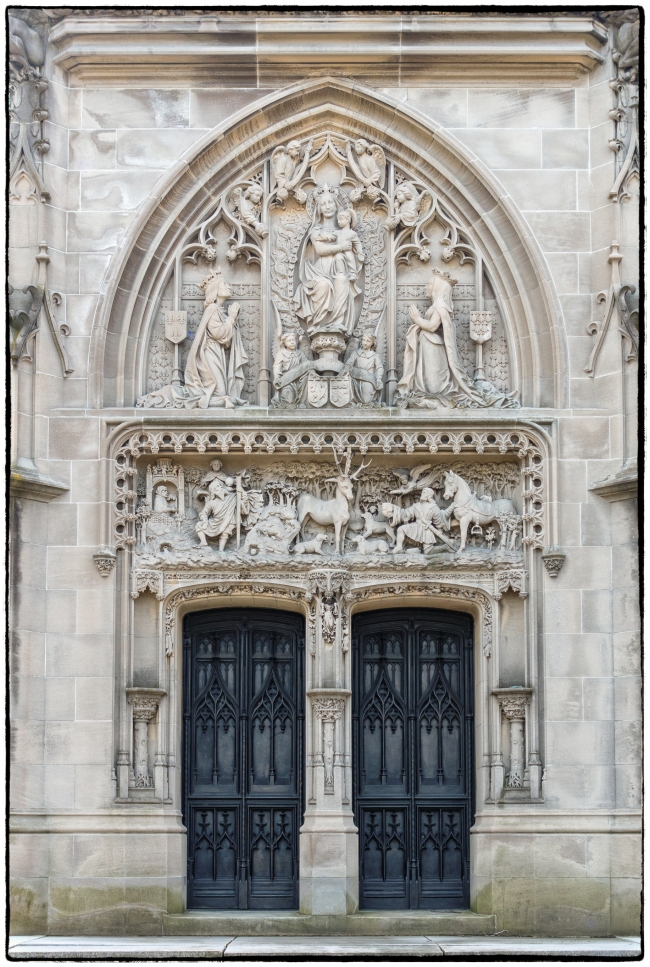And now we come to the Chapel of Saint-Hubert in the Queens section of Chateau Amboise in France’s Loire Valley. Designed by Leonardo Da Vinci early in the 16th Century, it’s in the late gothic ‘flamboyant‘ style.
According to Atlas Obscura:
Da Vinci’s wish was to be buried in the church of St. Florentin in Amboise, which took place on August 12, 1519. However the church was demolished during the French Revolution in the late 18th century (and later by Napoleon I). The alleged bones of Da Vinci were discovered in 1863 and moved to the Chapel of Saint-Hubert in the gardens of the Château d’Amboise. Today, the tomb can be visited on the left side of the tiny chapel, where two epitaphs (in French and Italian) hang on the wall describing his birth, death, and how he came to rest in the Chapel of Saint-Hubert.
No, hang on a minute! Although I’ve been to Amboise and the Chapel of Saint-Hubert, this isn’t it! But it is a pretty much exact duplicate serving as the mausoleum for Oliver Belmont (November 12, 1858 – June 10, 1908) and Alva Vanderbilt Belmont (January 17, 1853 – January 26, 1933) in Woodlawn Cemetery.
According to Douglas Keister on Mausoleums.com:
The Belmont version was designed by the architecture firm of Hunt & Hunt (1908) and fabricated in limestone by Barr Thaw & Frazer.
Architect R.H. Hunt, in designing the relief panels above the entry of the Belmont mausoleum made very few changes from the originals on the Chapel of St. Hubert in Amboise, France. The central figure in the lintel is a stag with what looks like a crucifix growing from its head. The crucifix is actually supposed to be wedged in its antlers and represents the stag that caused St. Hubert to convert to Christianity. Also occupying the panel are St. Hubert, patron saint of the hunt, St. Christopher, St. Anthony, dogs, angels, cherubs, and various woodland creatures. The tympanum’s central figure is the Madonna and Child flanked by the kneeling figures of Charles VIII of France and his Queen, Anne of Brittany.
Oliver Hazard Perry Belmont who rests beneath the protruding gargoyles of his mausoleum was hardly a religious man. O.H.P. Belmont’s great love was horses. He was the founder of the Belmont Raceway. He was also a financier and a U.S. representative in Congress from New York. After O.H.P. died, following an attack of appendicitis, his wife Alva Vanderbilt Belmont (she was previously married to William Vanderbilt), used large sums of her fortune to support the growing suffragette movement. Alva lived a long life, and, after her death in Paris in 1933, her remains were interred in the Belmont mausoleum. Interred along with Alva is the suffragette banner she carried, inscribed with the words, “failure is impossible”. The banner hangs inside the mausoleum. As early as 1917, Alva Belmont opened the mausoleum to the public and today it is frequently opened for tours given by the Friends of Woodlawn Cemetery.
R.H. Hunt and his father Richard Morris Hunt were partners in an architectural firm that specialized in designing residences for the rich and famous. Richard Morris Hunt designed residences for Alva when she was a Vanderbilt and R.H. Hunt designed this mausoleum for her when she was a Belmont. She may have switched husbands but she knew a good architectural firm when she found one.
The second and last pictures were taken with a Sony RX100M3 and the remainder with a Sony NEX 5N and Leitz 90mm f4 Elmar.
Entrance
Tympanum detail
Tympanum detail
Three quarter view





